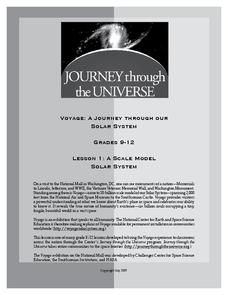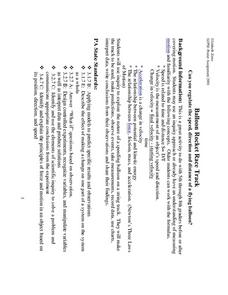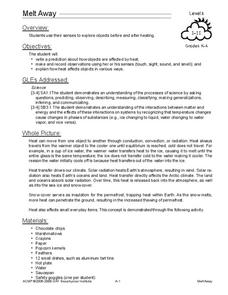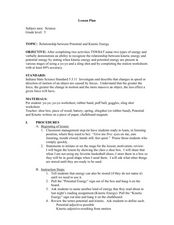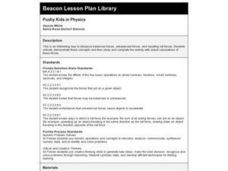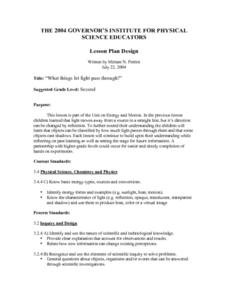Curated OER
Objects in the Sky
Students explore what the sky looks like at different times. They identify objects in the sky and recognize changes over time. Students observe the sky and look for objects that are common in both the daytime and the nighttime sky.
Center for Learning in Action
Introduction to the States of Matter
Liquids, gases, and solids are the states of matter in which scholars investigate in a lesson plan that offers in-depth information and engaging activities that look into the three states and the changes their properties make when mixed...
Center for Learning in Action
Properties of Balls
Enhance your states of matter lessons with a hands-on science investigation that compares six different balls' color, texture, size, weight, ability to bounce, and buoyancy.
Curated OER
Life Cycle of the Plant - The Pumpkin
First graders access prior knowledge about pumpkins and read the story Pumpkin, Pumpkin. They will sequence the life cycle of the pumpkin through the use of picture cards and then sing a song about the life cycle of the pumpkin and plant...
Curated OER
Move It!!!
Students explore motion by observing the movement of people and duplicating those movements. They compare and contrast various kinds of movements and identify different types of movements in pictures. They build an object that can be...
Journey Through the Universe
A Scale Model Solar System
Between the time scientists discovered Pluto and reclassified it as a dwarf planet, it did not even make one full revolution around the sun. In two activities, scholars investigate scale models and their properties. Pupils find that it...
Curated OER
What is the Attraction?
Second graders investigate the law of polarity. In this magnets lesson, 2nd graders discover how magnets are used in everyday life and which objects in our environment are magnetic. Students experiment with bar magnets and record...
Curated OER
Vectors: How Much Force Can You Apply
This lesson entails the viewing of two videos to get an overview of force and its application. The lesson covers how vectors use force in real-world situations.
Curated OER
Classify Forces
Third graders compare and contrast the forces of pushing and pulling. As a class, they take a field trip around the school and write down any action they see and any object that is motionless. In groups, they use magazines to cut out...
Curated OER
Balloon Rocket Race Track
Students discuss "How can we measure (or make it easier to record) the speed, distance or acceleration of the balloon?" They told that they are going to make a balloon racetrack. Pupils use meter sticks to accurately measure length and...
Curated OER
Force and Movement Assessment
In this recognizing the five forces that move objects worksheet, students identifying the movements, draw and label objects that use these forces, and draw directions of forces of objects. Students write 20 answers.
Curated OER
Melt Away
Students explore objects before and after heating using their senses. In this matter and energy lesson, students experiment with a variety of objects and use their senses (except taste) to make predictions and record observations...
Curated OER
Projectile Motion
Students determine the angle of launch that will give a projectile its greatest range. For this projectile motion lesson, students recognize that the motion of a projectile results from the combined horizontal and vertical velocities....
Curated OER
Relationship between Potential and Kinetic Energy
Fifth graders explore the relationship between potential energy and kinetic energy. In this energy lesson, 5th graders examine objects and describe potential and kinetic energy of the objects. Students complete two worksheets.
Curated OER
Cloud and Weather Patterns
Fourth graders examine how weather patterns generally move from west to east across the United States, and how clouds are formed and are related to the water cycle. They view and discuss a PowerPoint presentation of the types of clouds,...
Laboratory for Atmospheric and Space Physics
Charting the Progress of New Horizons
In 2006, New Horizons began its mission to fly to Pluto. As it continues its journey, scholars track its progress with the help of an informative website, all the while reinforcing measurement concepts with the construction of a scaled...
Savvas Learning
Let's Get Moving
Scholars examine, cut, paste, and sort 12 images featuring different types of movement in order to show what they know about energy—potential and kinetic.
Curated OER
Pushy Kids in Physics
Students examine the concepts of balanced forces, unbalanced forces, and resulting net forces. They participate in a force and motion demonstration by pushing students in various directions, and calculating and identifying the resulting...
Curated OER
Magnets-The Quicker Picker Upper
Second graders research the design of and purpose of magnets. They investigate a group of objects to discover which things are attracted to magnets. Observe the effect that lodestone has on iron fillings. Summarize observations.
Curated OER
What things let Light Pass Through?
Second graders classify objects according to how well light can pass through them and predict how well objects will transmit light. They experiment with objects to verify predictions while collecting, recording, and interpreting data...
Curated OER
Catapults!
Learners work together to discover the relationship between the angle of catapults and the flight of different objects. They discover the heavier the object the more force is needed. They examine how engineers use this information to...
Curated OER
Finger Painting and Feather Painting with Nature
Students explore finger painting and painting with feathers and recreate the look of objects in nature. They read the book, 'It Looked Like Spilt Milk,' create a shaving cream print, paint with feathers, and construct a mirror image on...
Curated OER
Aristotelian and Newtonian Motion
High schoolers use a quotation from Einstein as a reference to categorize their descriptions as either Newtonian or Aristotelian. They discuss the idealized nature of the Newtonian approach. Students describe the events they observe...
Curated OER
Air is something
Students recognize that air has the properties of mass and volume. They predict, observe, and evaluate the effect of the air on various objects, using bubbles and bubble wands.





